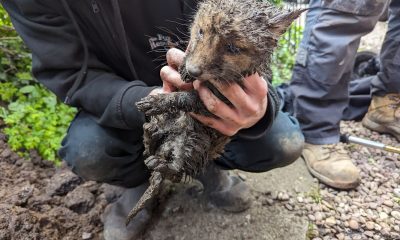Dangerous COVID-19 variant found in same species of deer as Bambi
Published
2 years ago onBy
Talker News
By Mark Waghorn via SWNS
People could catch a new and deadly form of COVID-19 ... from deer, scientists have warned.
At least three variants of the virus have been detected in wild white-tailed deer.
Walt Disney based his most loved character Bambi on the species - so it would be familiar to American audiences.
Now a study in Ohio has identified the animals as a potential reservoir for spreading more virulent strains to humans.
Senior author Professor Andrew Bowman, of The Ohio State University, said: "Based on evidence from other studies, we knew they were being exposed in the wild and that in the lab we could infect them and the virus could transmit from deer to deer.
"Here, we are saying that in the wild, they are infected. And if they can maintain it, we have a new potential source of SARS-CoV-2 coming in to humans.
"That would mean that beyond tracking what’s in people, we’ll need to know what’s in the deer, too."
He added: "It could complicate future mitigation and control plans for COVID-19."
SARS-CoV-2 is the virus that causes COVID-19. The trio of mutations were identified in over a third of 360 animals - at six different locations.
There was evidence of transmission between them - suggesting deer may facilitate the emergence of more lethal adaptations.
The first report of active COVID-19 infection was backed by the growth of viral isolates in lab experiments.
This showed the researchers had recovered viable samples of the SARS-CoV-2 virus - and not only its genetic traces.
The study in then journal Nature follows previous research by the US Department of Agriculture that foundCOVID-19 antibodies in wild deer.
Nasal swabs were collected from the deer between January and March 2021. It occurred before Delta swept the world. That variant was not present.
Genomic sequencing showed the strains matched those that were being carried by local patients withCOVID-19.
The team is now testing more samples to check for new as well as old variants.
Their continued presence would suggest the virus can 'set up shop' - and survive in wild deer.
Prof Bowman said: "The fact wild deer can become infected leads toward the idea we might actually have established a new maintenance host outside humans."
It is not known how the deer got infected, if they can infect humans and other species or how the virus behaves in the animals' body.
The scientists also need to find out whether it is a transient or long term infection.
Using PCR testing, they detected genetic material from at least three different strains of the virus in 129 (36%) of the deer checked.
The analysis showed B.1.2 viruses dominant in Ohio in the early months of the year spilled over multiple times into deer populations in different locations.
The lineage was dominant in humans in Ohio at the time.
Prof Bowman said: "The working theory based on our sequences is humans are giving it to deer, and apparently we gave it to them several times.
"We have evidence of six different viral introductions into those deer populations. It is not that a single population got it once and it spread."

Each site was sampled between one and three times, adding up to a total of 18 collection dates.
Based on the findings, researchers estimated the prevalence of infection varied from 13.5 to 70 percent across the nine sites.
The highest prevalence was observed in the four that were surrounded by more densely populated neighbourhoods.
Deer functioning as a viral reservoir would result in one of two likely outcomes, Prof Bowman explained.
COVID-19 would mutate in deer, leading to transmission of new strains to other species - including humans.
Otherwise, the virus could survive in deer unmutated while it simultaneously continues to evolve in humans.
At some point, when we don't have immunity to the strains infecting deer, those variants would come spilling back to us.
The researchers speculate white-tailed deer were infected through an environmental pathway - possibly by drinking contaminated water.
The virus is shed in human stool - and is detectable in wastewater.
Infections with SARS-CoV-2 linked to human exposure have been reported in cats and dogs, wildlife under human care such as mink and free-ranging wildlife.
Prof Bowman said: "The extent of susceptible host species and potential new reservoirs in which the virus can reproduce, evolve and potentially spill back to the human population is not fully understood."
The white-tailed deer tested for the study were part of a population control initiative, so are not a transmission threat.
There are an estimated 600,000 white-tailed deer in Ohio and 30 million in the US.
Prof Bowman said the sampling focused on locations close to dense human populations and is not representative of all wild deer.
He added: "The finding that white-tailed deer are susceptible to SARS-CoV-2 infection demonstrates the capacity for the virus to be transmitted into wildlife.
"No spillback into humans was observed, but the results suggest there may be potential for new SARS-CoV-2 variants to arise in animal reservoirs and alter the evolution of the virus.
"More monitoring of wildlife is needed to understand the transmission and evolution of SARS-CoV-2."
Stories and infographics by ‘Talker Research’ are available to download & ready to use. Stories and videos by ‘Talker News’ are managed by SWNS. To license content for editorial or commercial use and to see the full scope of SWNS content, please email [email protected] or submit an inquiry via our contact form.
You may like


Metals can heal themselves just like ‘The Terminator’


Two-faced star has hydrogen on one side and helium on other


World’s oldest big game hunting weapon found


An espresso a day could keep Alzheimer’s at bay


Being bipolar significantly raises risk of premature death: study


Soccer players who regularly use head more likely to develop Alzheimer’s
Other Stories


97-year-old veteran receives WWII service medal 80 years later
"We’re all so proud of Eve."


Fox cub saved by plumbers after getting stuck underground
The little mammal was trapped inside a four-inch-wide pipe.


Rare condition that stunts growth also reduces heart attack risk
Scientists believe that drugs that cause similar effects could reduce the risk of a heart attack or stroke.


Research reveals mice think just like human babies
Scientists say the mouse strategizing is comparable to how non-verbal human babies learn.


Harvard study reveals how pollution raises risk of heart attack or stroke
Air pollution is estimated to have caused millions of premature deaths worldwide.
Top Talkers

 Parenting1 week ago
Parenting1 week agoSingle mom details struggles of feeding her 12 kids

 Lifestyle1 week ago
Lifestyle1 week agoWoman regrets her tattoo nightmare: ‘It’s horrendous’

 Wildlife3 days ago
Wildlife3 days agoClever elephant returns visitor’s shoe that fell into enclosure

 Good News4 days ago
Good News4 days agoDisabled student takes first steps in 10 years on graduation stage

 Health4 days ago
Health4 days agoNew study reveals ‘old age’ begins later than it used to

 Entertainment1 day ago
Entertainment1 day agoWhat is the perfect movie length?

 Work2 days ago
Work2 days agoHow much does your workspace affect productivity?

 Travel4 days ago
Travel4 days agoOne-fifth of Americans think about their next vacation while still on vacation
